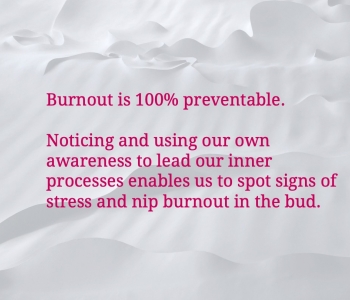Preventing Burnout – The Allure of Proactive Wellbeing
Burnout represents an inner condition that emerges when you become profoundly disconnected from your True Self and experience longer exposure to stress.
The World Health Organization (WHO) defines burnout as an occupational phenomenon: “Burn-out is a syndrome conceptualized as resulting from chronic workplace stress that has not been successfully managed."
Burnout is characterized by rising inner reactivity that leads to increasing stress levels and emotional exhaustion. It leads to a retreat from activities you formerly enjoyed and a noticeable decrease in your overall effectiveness. This all-encompassing state of depletion exerts a pervasive toll on both your personal and professional life, affecting you physically, mentally, emotionally, and even spiritually.
The state of burnout always arises gradually. Burnout happens due to prolonged experiences of fatigue and sustained (positive) stress or persistent emotional demands that stretch over the intrapersonal capacity to handle them for an extended period.
The signs and symptoms of burnout are unmistakable and are something that everyone should know, as too many people fail to make changes in their lifestyles.
Most burnout happens due to positive stress and leads to depletion that converts into a lack of wellbeing, inner power and self-motivation. This also reduces personal initiative without raising levels of outer motivation that are never giving satisfaction.
7 warning signs of burnout
Overthinking about your mental health problems can often cause overload and burnout, and your tendency to analyze every action exacerbates this. The more you will think, the worse you will feel as negative thoughts and emotions cloud your judgment.
Here, you need to step out of inner reactivity and thinking, as those prevent you from taking action. To address your burnout, you need to tackle your overthinking and subconscious reactivity.
That is why learning intrapersonal skills that allow you to observe your inner domain with awareness and change inner processes matters.
Noting the early indicators of burnout is crucial for preventing it. Here are some key warning signs to be vigilant about:
- Performance and engagement decline: Increased mental distance from the job, calming hobbies, and other responsibilities are common as feelings of negativism or cynicism related to work gradually appear. Burnout predominantly impacts our ability to be interested in and carry out routine tasks, especially in a professional context. Individuals experiencing burnout tend to exhibit negativity towards their responsibilities, struggle to maintain focus, and experience a significant drop in creative energy.
- Increased irritability: Slowly rising stress levels (including positive stress) often lead to heightened irritability and a reduced tolerance for minor frustrations or inconveniences. Everyday stressors that were once manageable may trigger intense emotional reactions, further contributing to emotional exhaustion.
- Disengagement from work: Those affected by burnout are often over-enthusiastic first, and then in later stages come to perceive their professional roles as aggravating and disheartening. A growing enthusiasm is the first sign, and then a shift to cynicism towards their work culture and colleagues usually follows. Emotional detachment and withdrawal from work-related tasks often become apparent, and the need for overstimulation continues (this is supported by extra coffee first, and followed then often by alcohol, recreational drugs, or Benji jumping or similar extreme activities enter the picture).
- Neglect of self-care: Individuals experiencing burnout often neglect self-care practices, including exercise, healthy eating, taking pauses, and an adequate amount of sleep. They often prioritize work or other responsibilities over their own mental wellness, which can exacerbate the mental, emotional, and physical symptoms of burnout.
- Depletion or noticeable reduction of individual wellbeing: Burnout often brings about a pervasive sense of fatigue, leaving us feeling overwhelmed, drained of energy, and lacking vitality. Physical symptoms, like gastrointestinal problems or even chronic pain (back pain, shoulder tension, and a headache are most common here) may also manifest.
- Social isolation: As burnout develops into its concluding phases, you tend to increasingly distance yourself from social interactions, including previously nurturing relationships. We may start avoiding social gatherings, neglecting communication, or even exhibiting reduced empathy as a way to protect ourselves from further emotional expenditure.
- Cognitive decline: Burnout can also manifest as cognitive impairments, such as forgetfulness, a diminished attention span or impaired problem-solving abilities. Tasks that once seemed effortless may become increasingly challenging, causing a cycle of failure and stress.
Recognizing and addressing burnout in its initial stages is essential for preserving our well-being and preventing its potentially devastating consequences on our lives.
Examine carefully this brief and insightful video to learn more.
While burnout isn't an illness, burnout overlaps with depression.
The overlap between depression and the final phase of burnout is between 86-92%. People who experience burnout at work are usually brilliant minds with outstanding professional skills.
Burnout can take a devastating toll on your top performers (leaders, experts), requiring lengthy periods of recovery in the final stages and even leading to them leaving the company.
Burnout can cause a serious financial setback for your organization, as it can result in lost productivity, decreased employee morale, loss of personal initiative, and increased turnover among your most valuable employees.
That is why stress reduction and burnout prevention in mind health training format is essential! It keeps your top talents and allows them to enjoy life and work for the years to come.
Conclusion
It's crucial to acquire intrapersonal skills while you are well, way before chronic stress appears.
Possession of intrapersonal skills allows the removal of inner reactivity, reduction of stress and timely self-care. It also permits making necessary adjustments to regain inner calmness and reconnect with our True Selves and the people around us.
As the WHO states, burnout is characterized by three dimensions:
- Feelings of energy depletion or exhaustion;
- Increased mental distance from one’s job or feelings of negativism or cynicism related to one's job;
- Reduced professional efficacy.
The good news is that burnout is fully preventable, and such prevention is just a few clicks away from you and your colleagues.
This burnout prevention blog post is written by Kaur Lass. Latest update 28.12.2024



